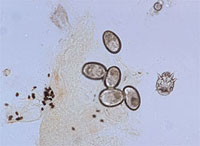|
| Fig. 3.6 A positive scraping for scabies showing an immature mite, eggs, and numerous fecal pellets. (Courtesy of James E. Fitzpatrick, MD.) |
The best method is to scrape a burrow and demonstrate the parasite inside it. A classic burrow appears as an irregular, linear, slightly elevated lesion, best found on the flexor wrists, fingerwebs, and genitalia. Eighty-five percent of adult male patients with scabies will have mites on the hands or wrists. Occasionally, the mite can be seen with the naked eye as a small dot at one end of the burrow. Following the application of mineral oil, on either the blade or skin, the burrow is scraped vigorously with a no. 15 scalpel blade, but not so vigorously as to draw blood. The mineral oil is collected from the skin and blade and transferred to a glass slide, which is then examined under the microscope. The diagnosis is established by identifying either the fecal pellets (scybala), eggs, or the mite itself (Fig. 3-6).
Hay RJ: Scabies and pyodermas—diagnosis and treatment,
Dermatol Ther 22:466–464, 2009.
